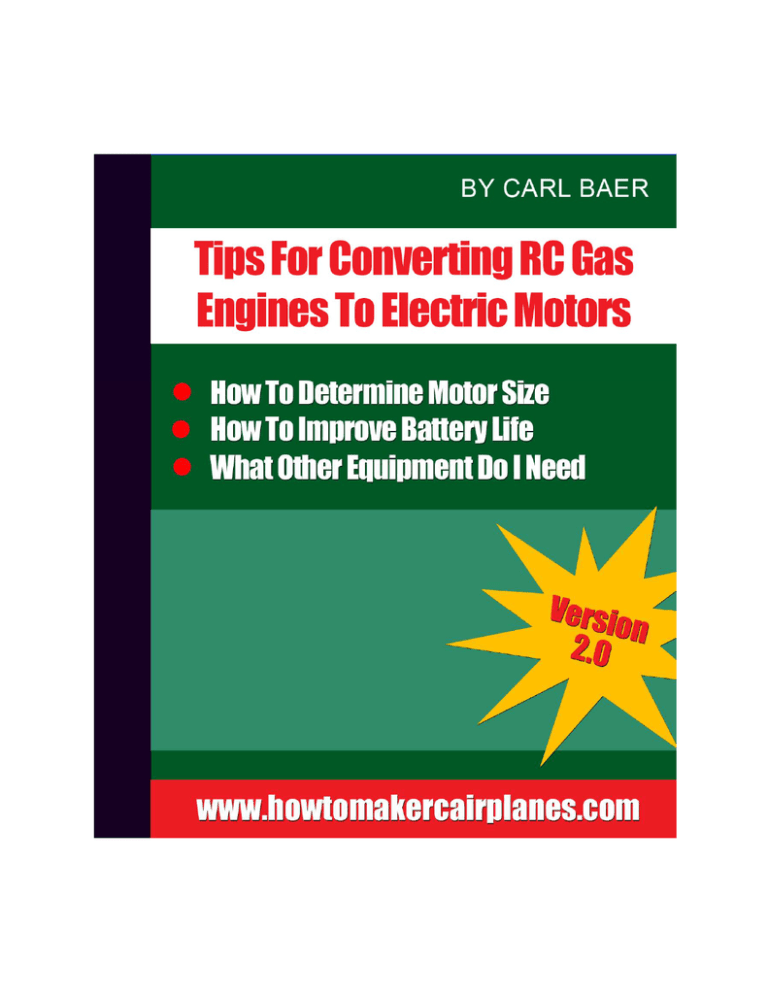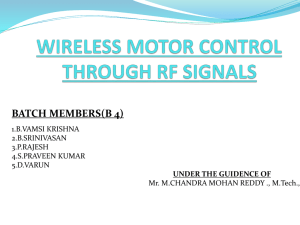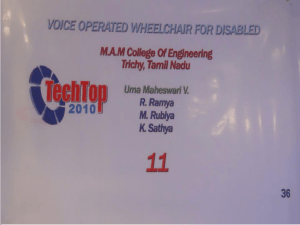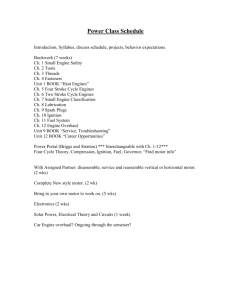
Tips For Converting RC Gas Engines To
Electric Motors.
By Carl Baer – Version 2.0 2008
Copyright © 2008 HowToMakeRCAirplanes.com & Carl Baer
Information in this documentation is the property of HowToMakeRCAirplanes.com & Carl Baer.
No part of this document can be reproduced or transmitted in any form or by any means (electronic,
photographic or mechanical), recorded, translated, or used to produce derivative works, without written
permission from HowToMakeRCAirplanes.com & Carl Baer.
All Rights Reserved.
1
Table of Contents
Introduction----------------------------------------------------------------- Page
Things To Consider Before Converting To An Electric Motor -----
3
Pages 4 - 6
How To Determine Motor Size For Your Model Airplane ---------- 7 - 10
Tips For Improved Performance From Lithium Polymer Batteries … 11
What Equipment Will I Need For Flying Electric Motor Planes-------- 12
Final Considerations With Glow To Electric Conversions --------------13 -14
Proper Rights Acknowledgements --------------------------------- Page 15
2
Introduction
Deciding to convert a gas engine from your already built radio control airplane
used to be a lot more difficult, for the simple reason that technology had not yet
caught up to the power to weight ratio of gas engines. That is not the case
anymore. Now we have brushless motors (which means there aren’t any internal
parts that are touching one another, causing less friction and heat generation,
which equaled more battery consumption). Another huge factor is battery
technology. With Lithium Polymer batteries, it is possible to power giant scale
aircraft with results that rival glow engines.
However, one of the biggest reasons to consider converting your glow engines to
electric motors has nothing to do with technology or the aircraft themselves. It
has to do with population growth. Simply put, many RC clubs are being
threatened to close because of land development. This is leading these clubs to
switch their rules and only allow electric motors to fly, so that they can conform
to the newly enforced noise abatement laws that homeowners are demanding.
Regardless of the reasons, it is good to remind ourselves that this is a hobby
where we are all interested in trying out new fangled technologies that can make
flying our models even more fun, and converting our gas engines to electric
motors is just as good a reason as any ☺.
3
Things To Consider Before Converting Your Glow Fuel Engine To An
Electric Motor
What you should consider before converting your rc airplane gas engine to an
electric motor system.
With the changes in rc electric motor technology it is possible to fly ANY size
model using rc plane electric motors. The biggest leap in making this possible has
been two fold. First we have model airplane electric engines that are powerful
enough, not to mention much more efficient, that they rival or even surpass
gas/slimers/smokers/nitro hogs, or whatever else you may call rc airplane gas
engines.
In fact you can expect to see an increase in the performance of a model airplane
in several areas. Your take-off is shorter, climb rate will increase and you can now
fly in areas that have noise restrictions.
The debate between the benefits of rc plane electric and gas motors are as
controversial as those between pc and Mac users. It will continue for as long as
they are both in existence.
Some questions you might be asking before you convert your rc model airplane's
gas engine to an rc electric motor...
How long will the battery allow me to fly? With today's Lithium Battery
technology, you can easily expect 10, even 20 minute flights, even in bigger
aircraft. The days of overheating the batteries and fire hazards are almost nonexistent. There are many add on features that you can now purchase that all but
eliminate battery hazards. Such as temperature monitors and voltage indicators.
4
Here are a few questions that will help determine what components to buy.
1. What is the radio control plane that you want to convert? Is it a trainer, sport
plane, 3D etc.. This is important because you will need to determine the electric
motor based on your models capabilities, and what you want it to do.
Example: Hangar 9 Arrow with a .40 size gas engine.
Would require an electric rc motor equivalent to an AXI 2826/12 External Rotor
Brushless.
This motor would allow this model to perform basic aerobatics with its semisymmetrical wing.
Specs of the Hangar 9 Arrow
You will need these numbers to help determine the motor, battery, and prop
requirements.
Wingspan: 63 in
Overall Length: 52.5 in
Wing Area: 710 sq in
Flying Weight: 5.7 lb (as a radio controlled gas plane)
Engine Size: converting a standard .40 size rc gas engine to an rc electric motor.
Now you need to determine what type of batteries you will need. This is based
mostly on your budget and time till land variable. In other words, how long do you
want to fly for and still get performance.
5
The most obvious choice is going to be a Lithium Polymer battery, this is the most
advanced battery technology available for rc model airplanes. They are also the
most expensive. Other older battery technologies are available, such as, lithium
ion and nickel metal hydride. They can do the job, but at a weight cost and flying
time consideration. So choose carefully.
In the Arrow Example: We will use a 4200 mAh 11.1V Li-Poly Pack. This was
determined based on the flight performance we were after, some aerobatics, but
mainly stable easy going flying. Nothing too extreme. (We will go over some
figures for how to determine the motor, based on the flight characteristics that
we want).
As with any gas rc plane conversion to electric (or any electric radio controlled
airplane for that matter), you will have to consider an ESC (electronic speed
control). This hooks up to the motor, battery, and receiver. You will need to pick
one that can handle the required number of battery packs, servos and have
programmable features. This will make life easier for you if you pick one that is
feature rich. Of all the components, this is one to spend a little more on. You will
be glad you did.
For this example, we used a 40 Amp Brushless Controller with Program features.
There are lots of manufacturers of ESC's so take the time to research them.
Prop Selection is an important consideration. You need to be aware that with an
electric conversion there is a possibility that your model plane will not have
enough clearance when using an electric motor prop. It may need modifications
to the landing gear (making them longer) so that the prop has clearance.
For the Arrow example we used an APC 13x10 propeller. Most electric motors
now have a table that you can find on their website that will recommend the
propeller range to stay within.
One final consideration with rc gas planes converted to electric. You always need
to factor in cooling of the battery pack and esc. In fact many modelers, including
myself, put the ESC on the outside of the plane, usually I mount it under the
engine on the firewall. You also need to make air vents to cool the battery inside
the model. Without this, you run the risk of overheating batteries and ESC's.
6
How To Determine Motor Size For Your Model Airplane
First let’s look at what today’s electric motors are all about. In the past you had
brushed motors, they overheated, were inefficient, and sapped battery power.
Usually you would have to add a gearbox to compensate for the inefficiency of
the brushed motor (and older battery technology). Lots of motors were melted in
those days. That’s not to say that you cannot melt an electric motor today, hook
up enough batteries to any electric component, and you will be assured to have a
melted motor ☺. Anyway, let’s look at where motor technology is today.
Brushless motors are exactly what they sound like, no part is “brushing” any other
part, less parts creating friction, means less heat, which means equals a more
efficient motor. (There is no motor that will ever be 100% efficient, based on the
laws of physics and thermodynamics, there is no way for any energy system to be
100% efficient). Today’s brushless motors are silent, gearless, and have lots of
torque (something to consider when you are taking off, too much torque is not a
good thing during take-off, think crashing).
However, because electric motors can produce varying amounts of power (based
on the battery configuration, they tend to be more difficult to choose for a
particular airplane.
Think of it this way…A larger gas tank will not make your glow engines
displacement increase (horsepower), BUT a larger battery will most certainly
increase the power of an electric motor. Think about that ☺.
Another important factor to consider with electric motors, they use a larger
propeller than their gas counterparts, remember this when allowing for ground
clearance for your propeller.
7
Which leads into the most often asked question. How do I determine the motor
size for my rc airplane?
It is based primarily on the individual just not having the basic equations and
theory that make the process much smoother. It does not completely remove any
error, but it does help to build your confidence when it comes time to do the
research to find your proper engine for your particular aircraft. After all, it is not
just an electric motor that is required, you have to figure in the ESC (speed
control), propeller and proper battery pack that will give you the power
requirement that you are after.
JUST A QUICK NOTE:
In this day and age, manufacturers of electric motors
have finally started to realize that people need an easy way to determine the
components that they will need in order to get the most out of their model
airplane. No one wants to be an electrical/mechanical engineer in order to
determine these figures. Well, they have listened and are now providing motor
combo packs, which include the motor and all the components that would be
needed to fly a particular model.
On that note….Let’s start at the beginning with looking at what power for electric
motors is based on… Watts.
A watt is just a measurement of energy, in this case we can equate the power to
something we are familiar with…horsepower.
1 Hp (horsepower) is equivalent to 746 watts.
This simple relation makes it clear for most glow engine flyers. Glow engines are
based on horsepower (displacement), and this shows the relation with watts,
which is the unit of measure used to determine power for an electric motor. See,
doesn’t that already clear up some preconceived confusion ☺ ?
Now let’s look at the Watt even closer and see how it is used to determine power
requirements when related to Amps and Volts.
1 Watt = Volts x Amps, and when we are talking about rc electric motors, we
usually start at around 30 Watts as the bare minimum to get a basic park flyer
into the air. This will change over time as motor and battery technology create
even more efficient products.
8
Now, even though output wattage in relation to the propeller is the determining
factor, it is much easier to determine what we will refer to as INPUT Watts (the
energy produced when we multiply battery voltage by the applied current in
amps, Don’t worry about this though). Just remember Input Watts.
Remember this General Rule of Thumb:
Keep Your Input Wattage Between 50 and 100 Watts/Pound (weight of your
airplane), and you will be covering most rc models that you will most likely be
flying. We will explain more below.
Using this knowledge, we can determine the power requirements when we use
these numbers for a particular model.
TIP: Determine the weight of your airplane, without the engine, gas tank, or any
other gas engine components, before you start looking at motor needs.
Here are a few guidelines to follow based on the type of aircraft you might be
flying. The numbers below will show how many watts are needed per weight of
the aircraft in pounds. Remember this when determining your power
requirements.
•
•
•
•
•
60 watts/pound. Usually a trainer or other slow flying plane. In other
words low wing loading.
100 watts/pound. Usually good for aerobatic capable planes, will also get
more speed at this power level. Once you get above this number, you are
looking at larger scale planes.
120 watts/pound. Expert level, we are talking about fully aerobatic
capable aircraft with high wing loading.
150 watts/ pound. This kind of watt power is best suited for entry 3D
models (super responsive, fast, aerobatic planes, straight up vertical on
take-off). Also good for jets with electric ducted fans.
Over 200 watts/ pound. You pretty much don’t need wings anymore.
These figures are based on today’s brushless motors. The motors today (as
mentioned above), do not “bleed” energy from the battery like older motor
technology did. In the “old” days (5 years ago), you needed a gearbox for your
electric motor to make up for the loss of efficiency from a brushed motor. That is
9
not the factor today, and this coupled with amazing battery improvements,
makes electric motors a good value.
Taking this knowledge, you can now make an informed decision towards choosing
the best fit solution for your models motor size requirements.
Here is a tip to remember when choosing your motor.
a. Motor manufacturers like to rate their motor by relating them to the
number of battery cells that are needed, current load (usually
continuous), and an on-demand full power load (full throttle).
Make sure that you know ahead of time what type of performance you would like
to get out of your airplane. This will help you to avoid being overwhelmed when it
comes time to make the purchase decision. It can also help in saving money by
avoiding the bigger is better trap that we all fall for when we do not have the
proper knowledge ahead of time. Take your time and pick out the components
that fit your plane.
As one final note: some electric motor manufacturers are making it even easier to
switch out glow engines for electric motors, they are doing this by creating model
numbers for electric motors that match their glow engine counterparts. For
example, a .40 size glow engine would now be replaced with a Model 40 electric
motor, which is what glow converters have been requesting for some time now.
10
Tips For Improved Performance From Lithium Polymer Batteries
• Always Cycle your batteries when you first get them. Then cycle them at
least three more times at a lower charge rate 1/3 less. This seasons the
batteries and will give you the best battery life and usage.
• Try not to discharge your packs beyond 80% of their capacity. The reason is
that it will keep your battery from heating up too much.
• Do not fly your plane past the point of reserve power, this will affect the
performance of the battery in the future.
• Always equalize your batteries after flying for the day. Do not leave them
half charged, this will affect their ability to accept a charge, hold a charge
and battery life.
• Always, always, always use the proper charger for the type of battery you
are using (Nickel Metal Hydride, Lithium Polymer). I don’t mention Ni-Cd
because they are pretty much obsolete, and they really should not be used
anymore anyway.
• Charging your batteries at the slowest charge rate will always give you the
best battery performance and utmost life of your batteries.
• Never leave any battery unattended while charging, especially Li-Po’s they
are the most dangerous to charge, but ironically the best battery
technology on the market for electric engines.
11
What Equipment Will I Need For Flying Electric Motor Planes.
Honestly, the equipment to fly electric planes is not that much different from your
glow engine equipment. Obviously you will not need a battery, fuel, or electric
starter anymore. These reasons alone seem to be a driving force in more and
more people putting their glow engines aside to make room for the convenience
of electric motors, and with the advances in electric motor technology, no need to
wire batteries in series or parallel for better battery management and the dangers
of lithium batteries almost eliminated it is no wonder we are seeing somewhat of
a revolution towards electric conversions.
Let’s look at the equipment that you will need to get up and flying.
BATTERY: Batteries are like fuel for a glow engine, and usually come in the range
of 500 to 2000 mAh cells, the higher the number, the more charge the battery can
hold. The weight of the pack is proportional to its capacity.
Electronic Speed Control:
ESCs like the Jeti Advance PLUS line have simplified programming further with the
use of a card that stays in your field box. New Lithium cells have eliminated the
need to parallel cells and increased safety through being non-combustible at high
charging voltages.
WATTMETER
Measures Voltage and current draw. It is good for measuring anywhere in the
circuit what is going on with the power system. Where is comes in handy, is
verifying how much current is being used in the system and how much the voltage
drops as you increase the current.
Charger
12
Final Considerations With Glow To Electric Conversions.
The biggest factor with converting to electric motors is becoming less of a factor,
but it is still worth mentioning here. Weight of your gas powered airplanes were
designed with a bulkier airframe to withstand the vibration that was generated
with a glow engine. Many large electric motors are comparable in weight to the
glow engines they are replacing. For instance a AXI 4130 motor, which is
equivalent to a .60 size 2 cycle engine, weighs about 14 ounces. While the glow
engine weighs about 18 ounces. So in fact, the electric motor is a little less, but
the weight of the batteries (depending on the performance desired) can weigh a
little more than a full fuel tank of gas. As we noted, this is changing and soon the
weight of batteries will not be a factor. Still, we need to take them into
consideration when converting our heavier older models to electric engines.
The final factors to consider are…
Ground clearance and balancing your model. Because electric motor usually turn
slower, they require larger propellers to increase the amount of area that is
needed to provide the thrust (after all a propeller is essentially the same as the
wing of your plane). This increase in size of propeller can mean that you need to
change the landing gear to a larger size to accommodate the propeller size
increase.
When it comes time to balance the plane with all the new components, you will
find the most productive way to balance is by using the battery placement as a
way to balance you plane. Moving the batteries around should be all that is
necessary to balance your plane. If more ballast or weight removal is required,
you can do things like drilling lightning holes in your fuselage or firewall. This will
not compromise the integrity of your airframe because the electric motor will not
“pound” the airframe the same way a glow engine does.
This covers the majority of issues that you will encounter when converting your
model to an electric engine. However, this is still Tips to help you get started. As
always I recommend seeking the advice of your rc clubs members for specific help
in areas that you are unclear of.
13
Or, you can contact me and I will be glad to answer your questions about glow to
electric conversions.
Good luck and happy flying,
Carl Baer
www.howtomakercairplanes.com
contact@howtomakercairplanes.com
14
Note: All References to Any Airplanes, Parts, Batteries, Construction Parts and any
others, are the trademarks and property of their respective manufacturers. They
are only used as examples for this booklet and not intended for any other
purpose.
15



